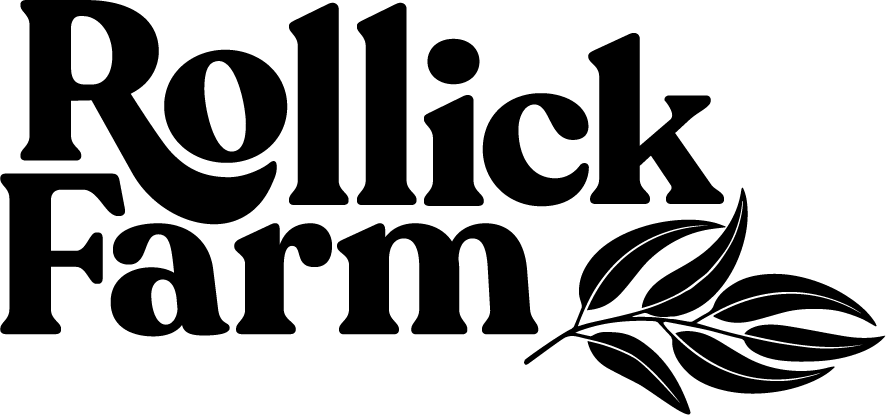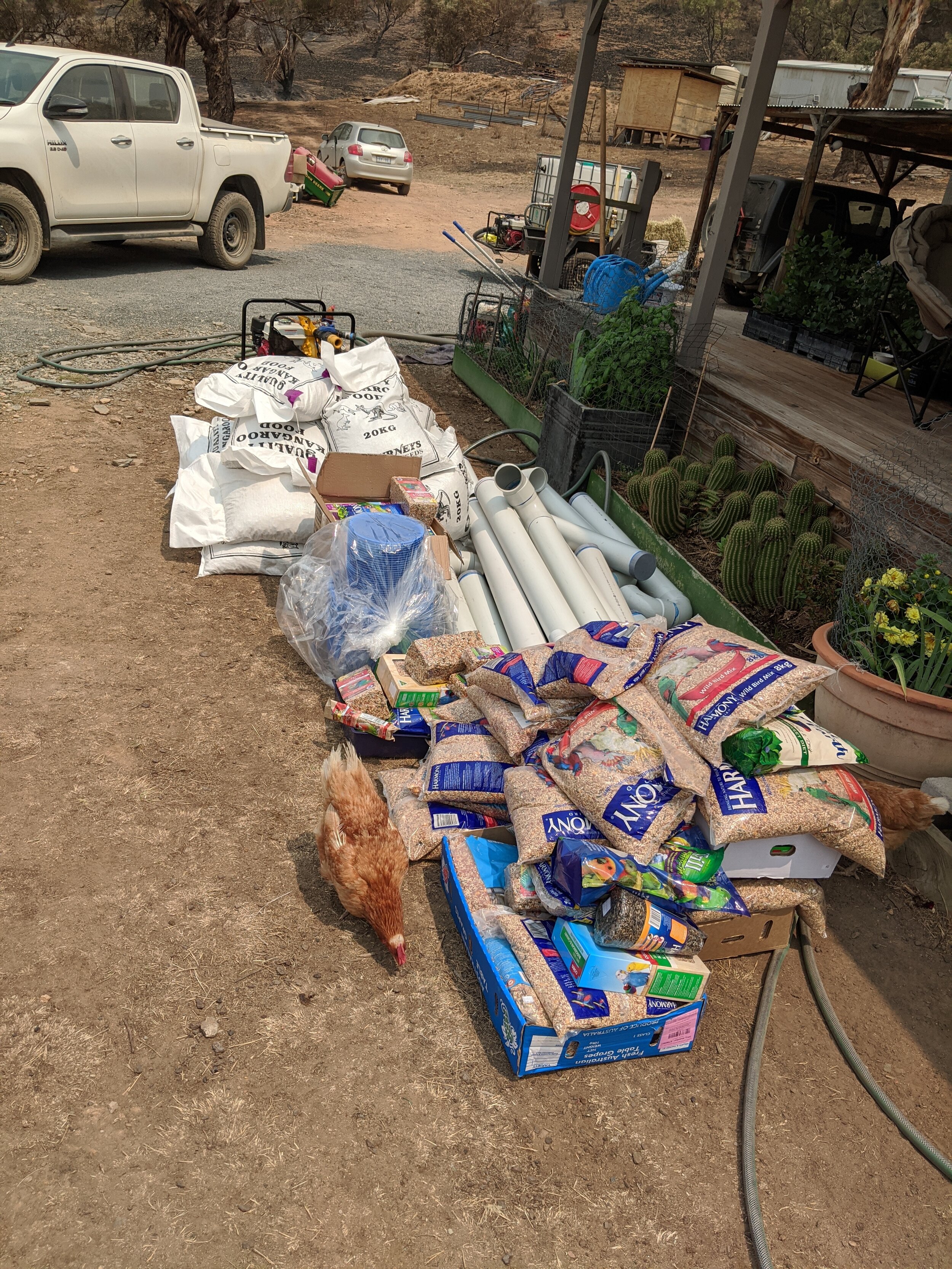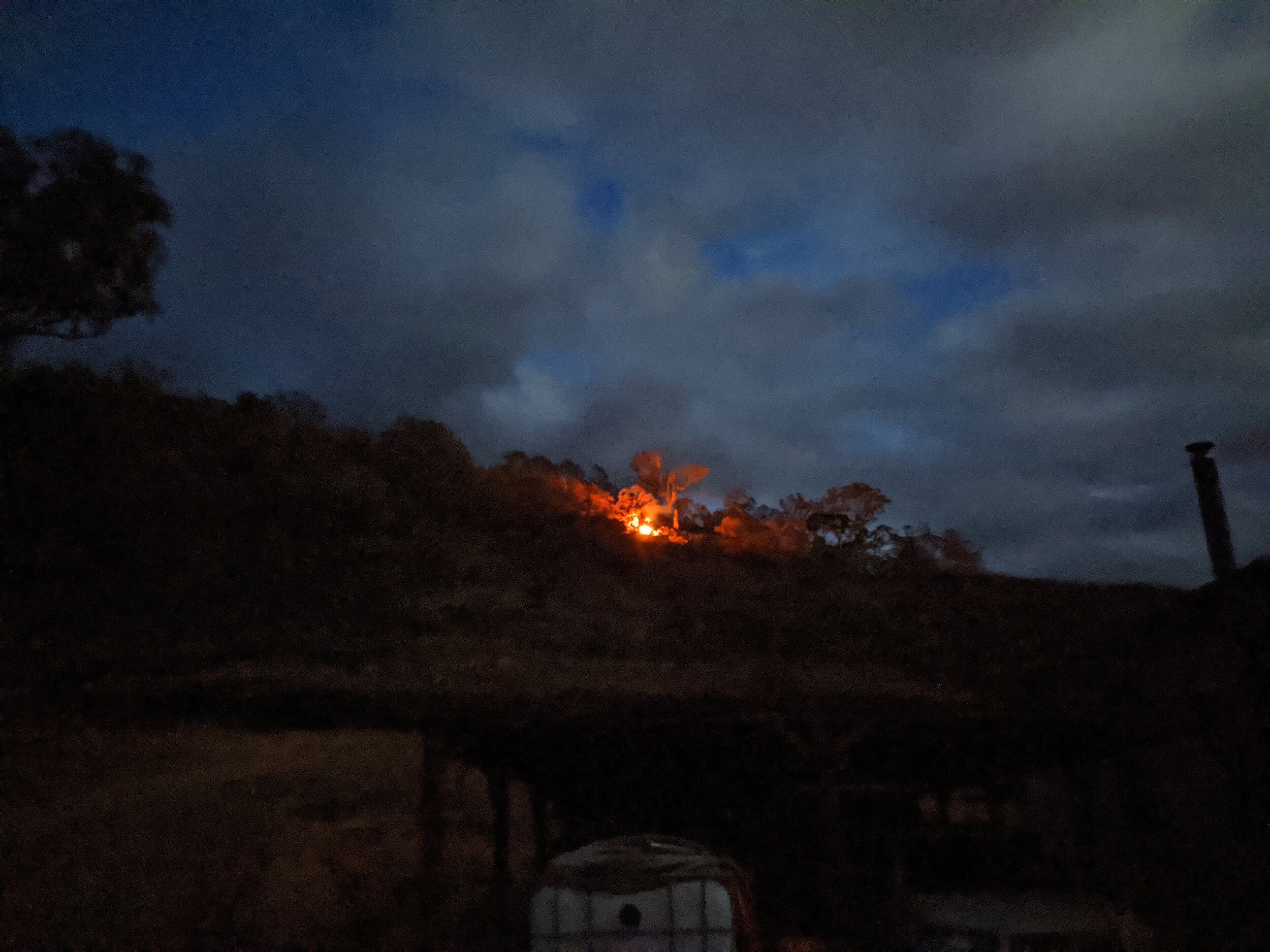2020 Bushfire Story 04: The Days After
This is the fourth post in a series on the bushfire. Start with the first post here.
At dawn on Sunday I walked around the front section of our property. The sky was red with morning light filtering through the smoke that hung in the valley. Charcoal tufts crunched under my boots while I walked, pausing every so often in the destruction. I saw Helen from next door doing the same on their place, we waved and shared a shell-shocked smile.
The burning husks of once mighty gum trees hundreds of years old were sending small plumes of smoke into the air, their crowns snapped off and crumpled on the ground. The charred bones of a monitor lizard were still warm. A wallaby with black skin hanging from its feet and legs had succumbed to its injuries in the night. There was death, silence and emptiness where there was once flourishing life.
Lost to the flames were one thousand native trees that we had planted to revegetate previously grazed paddocks. Many of our fence posts were still burning. Our water line was hardened goo or completely combusted, leaving us with no way to refill water tanks. But, we had saved our main structures and we still had a foothold in this place.
Matt needed to get back to Sydney for work, so after all owing us a chance to get some precious sleep he made his way back on Sunday. We heard from Stan and Charlie sometime in the morning. They’d made it safely back to Canberra and reported that as they left on Saturday, completely exhausted from firefighting all day, they had to navigate their way through more than ten RFS trucks parked up on the closed Monaro Highway a kilometre from Bumbalong Road. Apparently untasked, they were watching as Bumbalong continued to burn.
It is standard practice for RFS crews to extinguish smouldering logs and other material to prevent flare ups after a fire, so we thought we’d see RFS crews through the valley to work on the burning trees and logs around the roads and assets. None showed so around lunch time I called a senior member of our local RFS to see if they could send some help now that the main fire front had well and truly passed. The reply I received was ‘you’ve got plenty of water don’t you?’ I explained that our pump had failed. ‘Well, we’re pretty busy over this side of the river’.
Liz, a neighbour from down the road dropped into our place to see how we were getting on. We caught up and mentioned that we needed some help blacking out around the house. After speaking with us, Liz drove over to the fire shed. Seeing all four trucks parked there, she asked if some help could be sent down Bumbalong Road. The response was “Well if those on the other side of the river were more cooperative then maybe they’d get more help”.
On the way back from the RFS shed, Liz saw a NSW Fire and Rescue truck at the corner of Bumbalong road. She stopped and had a chat, sending them our way. They made it to us and were only too happy to help extinguish the tree behind the shed.
That whole turn of events made it pretty clear that in terms of RFS firefighting we were well and truly on our own.
But that’s what we had prepared for and on the Monday my mum Annie came over from Wagga to lend a hand. After picking up the last firefighting pump in Wagga and bringing it over along with some more solar gear, food and essentials she helped me black out the burning stumps and trees still putting our house at risk.
We also received some help from a helicopter that we had been watching doing runs up and down the river. On a return run we flagged them down and pointed to a big burning stump up the hill from the house. They timed the swing and dropped a bucket right down the chimney formed by the trunk of the huge old gum. We were elated, cheering and waving our appreciation as they circled to say ‘have a good one’.
The water bombing made a good start but it wasn’t quite enough to put the big stump completely out, so we connected multiple lengths of hose to the new fire pump and finished it off. It took around 500L of water before the stump stopped steaming.
Had the fire in the stump spread to the gum leaves and massive branches all around, it would have gone up quickly and then continued to burn for days, sending embers on the westerly wind towards the lovegrass around the house.
It was a long slog, but with that stump out, we’d done all we could on the fire around the house.
The ecological impact of the fire was revealed day by day. It’s clear now that thousands of animals perished on our property and millions upon millions died in fires across Australia. They were burnt alive by the heat of the fire or severely injured and later succumbed to dehydration, infection or other slow and painful ways to go. Others somehow escaped the fire unharmed but found the habitat that had until then provided shelter, food and water was now bare earth and charcoal.
The bush that had so reliably nourished our eyeballs and replenished our wellbeing now needed a hand.
To provide water for the injured wallabies and kangaroos hanging around our house I converted the water cubes in the refuge area into wildlife drinkers. C used socials to connect with volunteer wildlife organisations who delivered apples, sweet potatoes, equine feed, hay and deployable water stations. While we were still blacking out around the house Wildcare in Queanbeyan sent out a Subaru wagon full of feed. They would later make a number of trips to retrieve injured wildlife with a qualified wildlife darter tranquilizing the wallabies and wallaroos that could not be caught by hand.
We distributed food and drinkers into the areas that were safe to access and soon had mobs of kangaroos and more solitary swamp wallabies turning up each evening. After surviving years of drought and a catastrophic fire, they had earnt a good feed.
We’ve continued this practice of placing wildlife feed up in the mountains where feed is still very scarce. Trail camera footage show wombats, red necked wallabies, swamp wallabies, eastern grey kangaroos and one possum so far.
On Friday, six days after the fire, we left our place unpatrolled for the first time. We travelled into town to catch up with our neighbours at a pub in Canberra. For those who had lost their properties and vehicles it was more convenient to meet near their emergency accommodation.
The stories that were shared helped everyone piece together what had happened on the day. We heard that Mick and Karen had to leave their place with a few belongings in plastic shopping bags as the fire rapidly approached. They returned in the days after to find everything gone, their fishing boat lifted off its trailer by the wind and dropped again some distance away.
We heard about the support that had been provided to Tony and Nina by the Red Cross and others. Tony stayed with Kim and Helen on the Saturday night and was later hospitalised with burns. Tony told of his house burning along with all everything in it. All he had was his RFS uniform and boots. No wallet, phone, toothbrush, or shoes. We shared a laugh when he explained that the fluoro blue and green Velcro strapped runners he was wearing were the only ones in his size at Vinnies. They were pretty out there.
Those who hadn’t been in Bumbalong on the day told of watching in distress and disbelief as news reports and fire maps revealed the destruction. With everyone in the valley fighting the fire communications were slow to get out and there was uncertainty about the welfare of those who had stayed.
On speaking with Justin and Kim we pieced together events on the night of the fire. Justin had called me just on dusk, he asked for a hand down at his place. I got my gear on and headed down there. Justin had a lot of heavy equipment that he frequently used to maintain the road that services the valley. When I arrived he was standing near his fuel store shipping container that was well alight at one end. With water supplies exhausted and nothing else on hand he said ‘there’s nothing we can do about that now’. With my fire trailer out of action, and nothing much I could do with a rake hoe I agreed. We needed a fire truck.
On the way out I ran into Kim also on his way to assist. I explained the situation and Kim said he’d call for a couple of Cat 1 trucks, with plenty of water and foam. Kim, an RFS Deputy Captain, called the RFS and requested the trucks and was told they would be sent. They never arrived. The fire spread from the fuel store to adjacent equipment, trucks, tool shed and workshop.
Six days after the main fire front and the bush continues to burn, keeping us on edge.
On the drive home from the pub C and I talked through and processed the stories. When we got home, we found the power was back on and a large tree on fire up the hill, telling us it was not yet time to completely relax.
To regain a sense of control we made a broad a ninety day recovery plan in three phases that included things like cleaning up debris, refilling water tanks, replacing fencing and gates, scoping trenching and poly pipe required to restore water lines, repairing a melted dam overflow pipe. Having a plan provided something to refer to when answering the question, ‘what’s next’.
Thanks for reading. The photos here are all from the days immediately following the fire except the ‘carbonated’ air filter, I took that out of the Jeep a while after. With trees falling down all over the place it was a few weeks before we could walk up into the bush to get a look. I’ll share those photos in a future post.





























